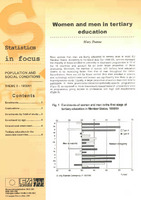Statistics in Focus: Population and social conditions. Women and men in tertiary education. 2001.18
| dc.contributor.author | Dunne, Mary |
| dc.date.accessioned | 2020-12-07T11:59:04Z |
| dc.date.available | 2020-12-07T11:59:04Z |
| dc.date.issued | 2001 |
| dc.identifier.issn | 1024-4352 |
| dc.identifier.uri | https://ketlib.lib.unipi.gr/xmlui/handle/ket/3419 |
| dc.description | Downloaded from EU Bookshop. |
| dc.description.abstract | More women than men are being educated to tertiary level in most EU Member States. According to the latest data (for 1998-99), women represent the majority of those enrolled in university or equivalent programmes in 12 of the 15 countries and account for an even larger proportion of those graduating. Moreover, the number of women with tertiary level education seems to be increasing faster than that of men throughout the Union. Nevertheless, there are still far fewer women than men enrolled in science and technology subject areas and women are significantly less likely to go on to postgraduate study. Equally, a larger proportion of women than men tend to participate in more practical/technical/occupationally-specific programmes (Type B) as opposed to more theoretically-based/research preparatory ones or programmes giving access to professions with high skill requirements (Type A). |
| dc.format.extent | 8p. |
| dc.language.iso | en |
| dc.publisher | Eurostat |
| dc.subject | Social Conditions |
| dc.subject | Educational training |
| dc.title | Statistics in Focus: Population and social conditions. Women and men in tertiary education. 2001.18 |
| dc.type | working document |
| dc.publisher.place | Luxembourg |

